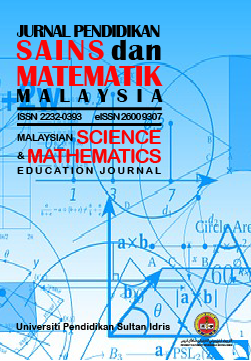Authentic Learning Approach in Science Education
Pendekatan Pembelajaran Autentik dalam Pendidikan Sains
DOI:
https://doi.org/10.37134/jpsmm.vol12.1.5.2022Keywords:
Authentic learning, Authentic Assessment, Science Education, Teaching ApproachAbstract
In this paper, the integration of authentic learning approach in science education have been discussed based on Herrington’s Authentic Learning approach. The nine elements are authentic tasks, authentic activities, expert views, multiple perspectives, collaboration, coaching and scaffolding, reflection, articulation and authentic assessment. These elements are integrated in the Science education to deliver meaningful lessons. In particular, the author had been able to propose a sample lesson plan for Year 6 Science subject. It consists of authentic context, authentic assignments, easily accessible learning sources that are realistic and tangible and freedom for the students to express their views and interpretations. The sample lesson plan is a practical implementation based on the Nine Elements of Authentic Learning Approach by Herrington & Herrington (2006). Together with proposed activities, teachers are able to plan and carry out their Science lessons more effectively with their students in order to produce more meaningful learning process. Authenticity in learning helps students to be more responsible and provide students a learning environment that they can be active learners, since the learning is altered to their profile.
Downloads
References
Banas, J. R., & York, C. S. (2014). Authentic learning exercises as a means to Influence preservice teachers’ technology integration self-efficacy and intentions to integrate technology. Australasian Journal of Educational Technology, 30(6). https://doi.org/10.14742/ajet.362
Baskaran, Vijaya & Abdullah, Norazilawati. (2020). Science Teachers’ Readiness in Implementing Authentic Learning Approach in Teaching and Learning. International Journal of Academic Research in Business and Social Sciences. 10. 10.6007/IJARBSS/v10-i8/7504.
Bhagat, K. K., & Huang, R. (2018). Improving learners’ experiences through authentic learning in a technology-rich classroom. In Authentic Learning Through Advances in Technologies (pp. 3-15). Singapore: Springer.
Donovan MS, Bransford JD, Pellegrino JW. How People Learn: Bridging Research and Practice. Washington, DC: National Academy Press; 1999.
Eng Tek, O., Safiee, N., Mat Jusoh, Z., Md Salleh, S., & Mohamed Noor, A. M. H. (2017). STEM education through project-based inquiry learning: An Exploratory study on its impact among year 1 primary students. Jurnal Pendidikan Sains Dan Matematik Malaysia, 7(2), 43-51. https://doi.org/10.37134/jpsmm.vol7.2.4.2017
Globe, (2021). A Worldwide Science and Education Program. Retrieved May 11, 2021, from https://www.globe.gov/documents/348830/55536461/Elementary+GLOBE+Teacher+Implementation+Guide/e316f57b-7690-4837-a95a-dfcaadd06a55
Halim, L., & Meerah, T. S. (2016). Science education research and practice in Malaysia. In M. H. Chui (Ed.), Science education research and practice in Asia: Challenges and opportunities (pp. 71–93). Singapore: Springer.
Har, L. B. (2013). Authentic learning. Hong Kong: The Hong Kong Institute of Education. Retrieved from www.ied. edu.hk/aclass/.
Herrington J, Kervin L. Authentic learning supported by technology: ten suggestions and cases of integration in classrooms. Educ Media Int. 2007;44(3):219-236.
Herrington, J. (2006, October). Authentic e-learning in higher education: Design principles for authentic learning environments and tasks. In E-Learn: World Conference on E-Learning in Corporate, Government, Healthcare, and Higher Education (pp. 3164-3173). Association for the Advancement of Computing in Education (AACE).
Herrington, J., Parker, J., & Boase-Jelinek, D. (2014). Connected authentic learning: Reflection and intentional learning. Australian Journal of Education, 58(1), 23-35.
Herrington, J., Reeves, T., & Oliver, R. (2006). Authentic Tasks Online: A Synergy Among Learner, Task and Technology. Distance Education, 27(2), 233-247
Herrington, J., Reeves, T.C., & Oliver, R. (2010). A Guide to Authentic e-Learning. London and New York: Routledge.
Herrington, J., Reeves, T.C., & Oliver, R. (2014). Authentic Learning Environments. New York: Springer
Johnson, L., Brown, S., Cummins, M., & Estrada, V. (2012). The technology outlook for STEM+ education 2012-2017: An NMC horizon report sector analysis (pp. 1-23). The New Media Consortium.
Latham, G., & Carr, N. (2012a). Authentic learning for pre-service teachers in a technology-rich environment. Journal of Learning Design, 8(3), 65-66
Lombardi, M. M. (2007). Authentic learning for the 21st century: An overview. Educause Learning Initiative Paper,1(2007). http://alicechristie.org/classes/530/EduCause.pdf. Accessed 20 Dec 2014
Ministry of Education Malaysia. (2013). Malaysia Education Blueprint 2013-2025.
Organisation for Economic Co-operation and Development (OECD) (2012). PISA 2012 assessment and analytical framework: Mathematics, reading, science, problem solving and financial literacy. Retrieved, from https://www.oecd.org/pisa/pisaproducts/PISA%202012%20framework%20e-book_final.pdf
Roth, W. M. (2012). Authentic school science: Knowing and learning in open-inquiry science laboratories (Vol. 1). Springer Science & Business Media.
Rule, A.C. (2006, August). Editorial: The components of authentic learning. Journal of Authentic Learning, 3(1), 1-10. Retrieved from Directory of Open Access Journals database.
Sabudin, G., & Halim, L. (2020). Kajian sistematik: Pendekatan pengajaran dan impak khazanah pengetahuan dalam pembelajaran sains. Jurnal Pendidikan Sains Dan Matematik Malaysia, 10(1), 21-38. https://doi.org/10.37134/jpsmm.vol10.1.4.2020
Science Curriculum Standard Document for Year 6 (2021 Edition)
Semerci, N., & Yelken, T. Y. (2010) ilköğretim programlarındaki ortak temel becerilere ilişkin öğretmen görüşleri (Elazığ ili örneği). Fırat Üniversitesi Doğu Araştırmaları Dergisi, 8(2), 47-54
Stein, S. J., Isaacs, G., & Andrews, T. (2004). Incorporating authentic learning experiences within a university course. Studies in Higher Education, 29(2), 239-258
Yahaya, N., Rasul, M. S., & Yasin, R. M. (2017). Exploring the authentic teaching and learning experience of the apprentices of the national dual training system. International Journal of Academic Research in Business and Social Sciences, 7(3), 690-703.
Zemelman, S., Daniels, H., & Hyde, A. A. (2005). Best practice: today's standards for teaching and learning in America's schools. 3rd ed. Portsmouth, N.H.: Heinemann.





